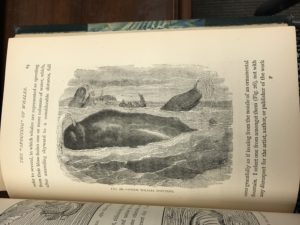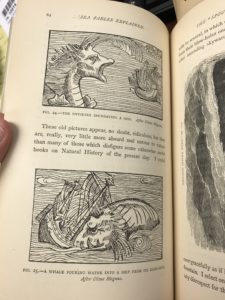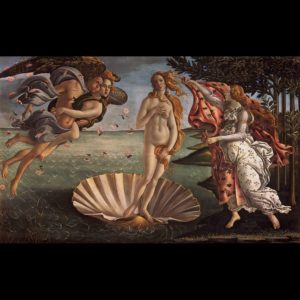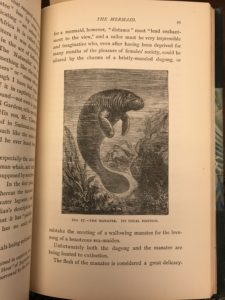Imagine, if you will, a creature with a lower body made of the skin and scales of a carp, a human-like upper body with prominent ribs, “thin and scraggy” arms, “skeleton-like” fingers, the head of a small monkey, and the teeth of a catfish. Sound familiar? While it may not match the image many of us may think of when we hear the word “mermaid,” this rather shocking description is just one of many presented in a small book called “Sea Fables Explained” (292 .L51v).
 Fig. 13.--A Japanese Artificial Mermaid. Lee, "Sea Fables Explained," 27.
Fig. 13.--A Japanese Artificial Mermaid. Lee, "Sea Fables Explained," 27. Henry Lee, "Sea Fables Explained" (London: William Clowes and Sons, Ltd., 1883)
Henry Lee, "Sea Fables Explained" (London: William Clowes and Sons, Ltd., 1883)
In 1883, Henry Lee, “Sometime Naturalist of the Brighton Aquarium and Author of ‘The Octopus, or the Devil-Fish of Fiction and Fact’” and other titles, published “Sea Fables Explained,” a companion to the International Fisheries Exhibition in London that same year. The book is a follow-up of sorts to Lee’s popular handbook, “Sea Monsters Unmasked,” which was also published in connection with the exhibition. The handbooks were small and brief, only 122 pages long and containing 42 illustrations. Published for the price of one shilling each, the book’s inexpensive cost meant that Lee had to limit his subjects and illustrations to the most interesting and important. As such, he wrote six chapters: The Mermaid; The Lernean Hydra; Scylla and Charybdis; The “Spouting” of Whales; The “Sailing” of the Nautilus; and Barnacle Geese—Goose Barnacles. Lee identifies his goal of the text to be the distinguishing “fiction from truth” regarding fables of sea creatures and their behaviors; he explains that most fabled sea monsters can actually be identified as real creatures whose oddities can be accounted for with science.
 Fig. 26--Sperm Whales Spouting. Lee, "Sea Fables Explained," 65.
Fig. 26--Sperm Whales Spouting. Lee, "Sea Fables Explained," 65.
One of the confusions Lee aims to clear up is the common misconception that whales spout water through their blowholes. Whales’ blowholes, Lee explains, are the mammals’ nostrils, located conveniently on top of their heads so that they can exhale and continue swimming mostly underwater; that way, whales only need to clear the surface enough to forcefully push out the air in their lungs. The reason why water can be seen spouting up from the blowhole with the escaping air is that the water at the surface of the ocean gets spouted up by the powerful gust of air leaving the blowhole. Science, Lee argues, can explain all the amazing--and bewildering--behaviors of the earth’s aquatic creatures.
 Fig. 24.--The Physeter Inundating A Ship; Fig. 25.--A Whale Pouring Water Into A Ship From Its Blow-Hole. Lee, "Sea Fables Explained," 64.
Fig. 24.--The Physeter Inundating A Ship; Fig. 25.--A Whale Pouring Water Into A Ship From Its Blow-Hole. Lee, "Sea Fables Explained," 64.
Mermaids put a bit of a wrench into this generality, however, as Lee explains that they have their history in ancient mythologies, whose imagery and narratives were changed over time and reduced to symbols like the one we recognize today of half-man, half-fish. In fact, Lee states that mermaids have been “known to every generation of men.” Some of the heroes and gods imagined in connection with fish were Noah, survivor of the great flood, and the Hindu god Vishnu, who is illustrated as emerging from a fish’s mouth; in fact, Lee argues that the mermaid fable derives from the idea of a deity coming out of a fish (as opposed to being physically part-fish). Even Venus, goddess of love, was a reimagination of Noah, “second father of mankind, the repopulator of the earth,” as she rises from the sea--a well-known representation in the history of art--as a “representative of the reproductive power of Nature.”
 Sandro Botticelli, The Birth of Venus (c. 1486). Tempera on canvas. 172.5 cm × 278.9 cm (67.9 in × 109.6 in). Uffizi, Florence.
Sandro Botticelli, The Birth of Venus (c. 1486). Tempera on canvas. 172.5 cm × 278.9 cm (67.9 in × 109.6 in). Uffizi, Florence.
Mermaids were a popular fascination during the nineteenth century, with P. T. Barnum famously exhibiting a “Feejee Mermaid” in the 1840s. Barnum’s bizarre mermaid—with the upper body of an apeand the lower body of a fish—looked much like the one illustrated in Lee’s handbook and, in fact, the description provided at the beginning of this post. Lee’s text is illustrated with a number of fascinating images and multiple accounts of mermaid encounters from around the globe, including a tale of a merman sighting in Virginia, along the Rappahannock River! Seals and manatees, Lee explains, are common culprits in the case of mermaid misidentifications, which continue to occur even in the twenty-first century.
 Fig. 17--The Manatee. Its Usual Position. Lee, "Sea Fables Explained," 45.
Fig. 17--The Manatee. Its Usual Position. Lee, "Sea Fables Explained," 45.